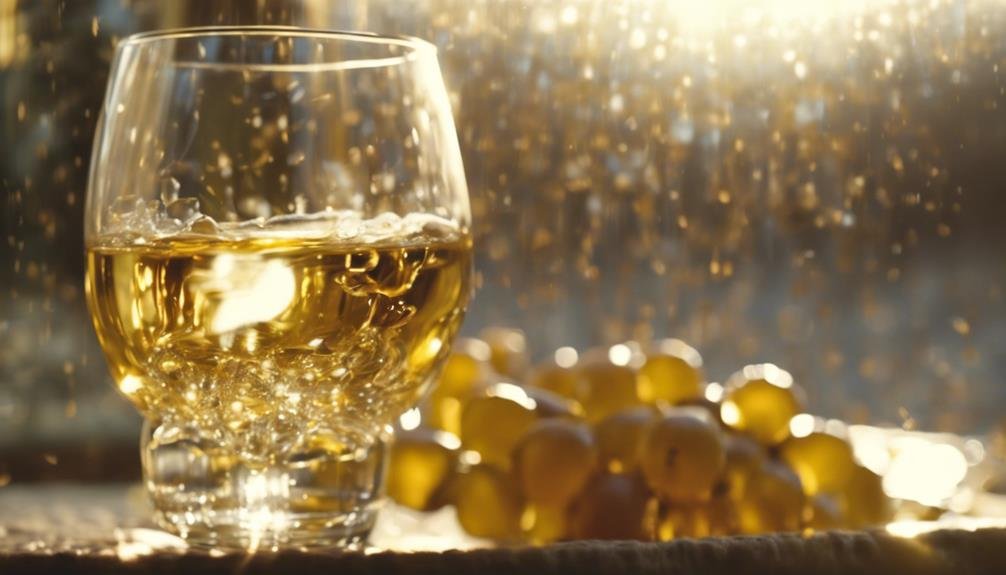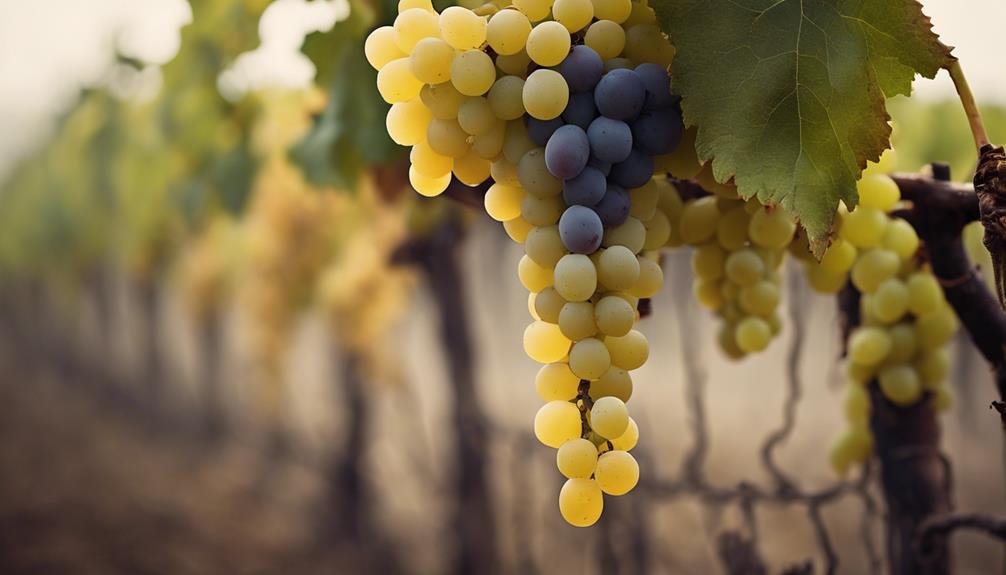Begin a fascinating journey into the world of Sauternes wine, renowned for its remarkable sweetness and flavor concentration. The golden elixir is crafted through the noble rot process, enhancing its complexity with notes of honey, apricot, and pineapple. Take part in the Sauternes Tasting Challenge to uncover perfect food pairings, savor its diverse tastes, and understand its nuances fully. Witness how Semillon and Sauvignon Blanc grapes, along with the influence of Noble Rot, shape this exquisite wine. Explore the secrets behind Sauternes' production and its harmonious blend of tradition and innovation. Delve into the enchanting world of Sauternes!
Sauternes Wine: Sweetness and Concentration
Sauternes wine stands out for its remarkable sweetness and concentration, attributes that captivate wine enthusiasts worldwide. Unlike dry wines, Sauternes offers a lusciously sweet flavor profile characterized by honey, apricot, pineapple, and lemon notes.
The concentration of flavors in Sauternes is achieved through the unique process of noble rot, or Botrytis cinerea, which wicks moisture from the grapes, leading to highly concentrated juice. This fungus adds a distinctive moldiness that enhances the complexity of Sauternes, distinguishing it from other dessert wines.
The interplay between sweetness and concentration in Sauternes creates a harmonious balance that delights the palate and sets it apart in the world of wines.
Botrytis Cinerea: The Golden Factor
The golden factor in the production of Sauternes wine lies in the influence of Botrytis cinerea fungus. This moldy grape transformation is pivotal in creating the dessert wine treasure known for its rich sweetness and complexity.
Botrytis cinerea, also called noble rot, wicks moisture from the grapes, leading to a concentration of flavors and sugars in the juice. The fungus adds unique flavors, such as honey, ginger, and apricot, elevating Sauternes to a level of sophistication unparalleled in the wine world.
Through this natural process, the grapes undergo a remarkable change, resulting in a wine that is highly sought after for its luscious, golden elixir-like qualities.
Sauternes Tasting Challenge: Weekly Improvements

Enhancing palates through a weekly tasting challenge that explores the nuances of French Sauternes reveals the intricacies of this renowned dessert wine. Participants develop a deeper understanding of Sauternes' flavor profiles and perfect wine pairing combinations. Below is a table summarizing the weekly improvements in the Sauternes tasting challenge:
| Weekly Improvements | Description |
|---|---|
| Wine Pairing | Discovering ideal food matches for Sauternes. |
| Flavor Profiles | Recognizing the diverse tastes within Sauternes. |
| Tasting Techniques | Refining methods to fully appreciate Sauternes. |
| Palate Development | Enhancing sensitivity to Sauternes' complexities. |
| Comparing Regions | Contrasting Sauternes with other dessert wines. |
Sauternes Production: From Grapes to Bottles
From the vineyards of Bordeaux's sub-region Sauternes to the meticulously crafted bottles, the production process of this esteemed dessert wine intricately weaves together nature's elements and human expertise.
The journey begins with the transformation of grapes affected by the noble rot, Botrytis cinerea, enhancing their sweetness and complexity. After careful harvesting, the grapes undergo pressing and fermentation to extract the concentrated juice.
The winemaking artistry continues with aging in oak barrels, allowing the wine to develop its signature rich flavors and aromas. Finally, the bottling process seals the golden elixir, ready to delight wine enthusiasts worldwide.
Sauternes' production, blending tradition and innovation, results in a luxurious wine that captivates with each sip.
Key Players in Sauternes: Semillon, Sauvignon Blanc, Noble Rot

Frequently overshadowed by its more renowned counterparts, Semillon, Sauvignon Blanc, and Noble Rot play pivotal roles in shaping the distinct character of Sauternes dessert wine.
- Semillon Sweetness: Semillon grape variety contributes luscious sweetness and a rich, round body to Sauternes, creating a velvety texture on the palate.
- Sauvignon Acidity: Sauvignon Blanc brings invigorating acidity that balances the intense sweetness of Semillon, adding brightness and vibrancy to the wine.
- Noble Rot: Also known as Botrytis cinerea, Noble Rot is a fungus that infects the grapes, causing dehydration and concentrating the sugars, flavors, and aromas, resulting in the unique and complex taste profile of Sauternes.
Frequently Asked Questions
How Does Noble Rot Affect the Taste of Sauternes Wine?
Noble rot, a beneficial fungus, shrivels grapes and concentrates their sugars, transforming Sauternes wine. This process imparts unique flavors of honey, apricot, and peach, balancing sweetness with acidity. The resulting flavor profile of Sauternes is complex and delectable.
Why Are Most Sauternes Wines Sold in 375 ML Half Bottles?
Most Sauternes are sold in 375 ml half bottles due to the wine's richness and aging potential. This format keeps the wine fresh after opening, ensuring peak enjoyment of the concentrated flavors and sweetness.
What Makes Second Growth Sauternes Wines a Good Value Option?
Second growth Sauternes wines offer a strong value proposition by delivering a similar quality experience to grand cru wines at a more affordable price point. With their excellent aging potential, these wines provide a cost-effective option for discerning wine enthusiasts.
Why Is Semillon a Key Player in Sauternes Production?
At the core of Sauternes production, the Semillon grape stands as a vital player, infusing the wine with both sweetness and body. Its unique ability to maintain a delicate balance of sweetness elevates Sauternes to unparalleled heights.
How Does Sauvignon Blanc Contribute to the Balance of Sauternes Wine?
Sauvignon Blanc in Sauternes contributes acidity, balancing its sweetness. It enhances aroma profiles with citrus, herbal notes, complementing Semillon's richness. This harmonious blend creates a well-rounded, complex dessert wine, showcasing the best of Bordeaux's noble rot-affected grapes.
Conclusion
In the world of fine wines, Sauternes stands as a golden elixir, a symphony of sweetness and complexity. Like a masterful painting, each sip reveals layers of flavor, crafted by the noble rot and skilled winemakers.
Through the tasting challenge, we uncover the magic of Sauternes and the artistry behind its production. This exquisite wine embodies the epitome of elegance and sophistication, mesmerizing the senses with its opulent charm.